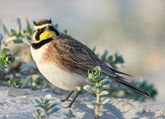ISSS608 2017-18 T3 Assign Tan Yong Ying Insights
|
|
|
|
|
|
Using the bird call collection and the included map of the Wildlife Preserve, characterize the patterns of all of the bird species in the Preserve over the time of the collection. Please assume we have a reasonable distribution of sensors and human collectors providing the recordings, so that the patterns are reasonably representative of the bird locations across the area. Do you detect any trends or anomalies in the patterns? Please limit your answer to 10 images and 1000 words.
Note: Since we only have sufficient data points for most of the species from Year 2010 onwards, we will exclude any bird recordings before Year 2010. Also, as we have recordings only for Q1 in 2018, Year 2018 is also excluded from our analysis.
- Bent-beak Riffraff: They are predominantly found in the western region of the Preserve, but their hangout spots are not consistent through the years.
- Blue-collared Zipper: In Year 2014, they were only making calls and not songs. In Year 2015, they were not spotted in the Preserve at all. In Year 2016, they returned to the Preserve and went back to their favorite spot pre-2015.
SS here - Bombadil: They have stayed in the same location in the northeastern part of the Preserve between 2010 and 2017, and no major changes in their spatial distribution were observed.
- Broad-winged Jojo: They have a favorite spot at the southwestern part of the Preserve. There was an anomaly in year 2015, as high concentrations of them were found away from their favorite spot. They were only making calls and not songs. They returned to their favorite spot in Years 2016 and 2017, but overall their concentrations have dropped. This suggests that something may have happened in Year 2015 which caused them to stop singing, and subsequently experience a drop in their numbers overall.
SS here - Canadian Cootamum: They have a favorite spot in the northwestern part of the Preserve. No major changes in their spatial distribution were observed.
- Carries Champagne Pipit: They have a favorite spot at the southeastern part of the Preserve and had not moved away from it throughout the years. While they consistently make calls in that location each year, their songs are rare in general and they are found singing in different parts of the Preserve in different years.
- Darkwing Sparrow: They were only recorded from Year 2014 onwards. They had stayed in the northwestern part of the Preserve in Years 2014 and 2015, but their concentration there decreased in 2016 and they had mostly shifted away to the southwestern part of the Preserve in 2017. However, this observation may not be representative of the species’ activity since it only has four years of data as compared to other species with seven or eight years of data.
Maybe SS here - Eastern Corn Skeet: They have a favorite spot near the center of the Preserve and have not moved away from it. Sometimes they are found singing in other parts of the Preserve.
- Green-tipped Scarlet Pipit: They have a favorite spot at the southwestern part of the Preserve. However, they are also regularly found in other parts of the Preserve in higher concentrations as compared to other species. However, there is a strange observation in Year 2015: while none of them were spotted at their favorite spot, there was a high number of them at the alleged dumping site. They returned to their spot in years 2016 and 2017, but their concentrations had started to drop in Year 2017. Something might have happened at the alleged site in 2015 which attracted their attention, but may have also caused the subsequent drop in their numbers.
SS here
Banner image credit to: Marshal Hedin
